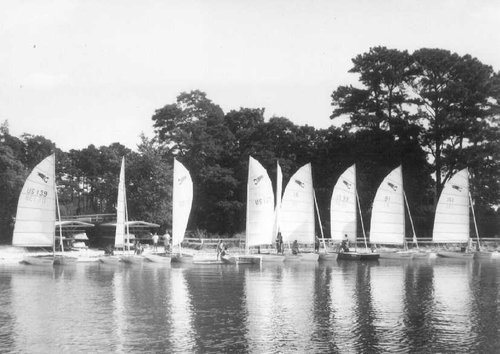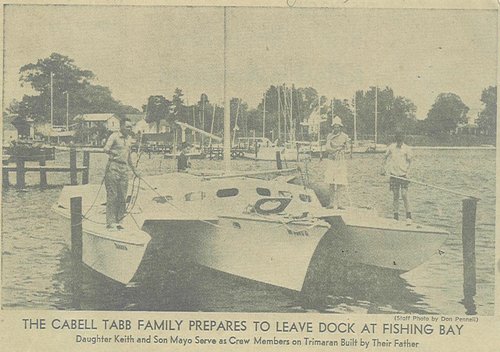Buddy Ebsen, the late Hollywood actor of “Beverly Hillbillies” fame and avid catamaran sailor, was fond of saying: “There are only three types of sailboats – cats, half-cats, and cats-and-a-half.”
Significantly, side by side articles in the August 1963 Log heralded the arrival at FBYC of the Cougar Catamaran fleet formation and the launching of Cabell Tabb’s 35-foot Piver-designed trimaran, Tamaria. The multi-hull revolution that some predicted would eventually dominate the sailing scene had arrived at our doorstep.
Multi-hull sailboats had been around for a long, long time. 2000 years ago in India, two-log boats were built called “Catturmarans,” meaning “tied logs.” Later designs were developed and refined by the Polynesians as graphically depicted by artists accompanying Capt. James Cook on the H.M.S. Endeavor in a voyage of discovery to the South Seas from 1768-71. However, history had to wait until 1876 when Nathaniel Herreshoff captured the imagination of the sailing world with his lightning-fast catamaran designs. The most famous of these designs was the Amaryllis that was so much faster than traditional mono-hulls that she was banned from racing. Discouraged, Herreshoff gave up his experiments with catamarans. As a consequence there were no major multi-hull developments until after World War II.
In 1948, the Prout Brothers, Roland and Francis, in the UK joined two canvas canoes together, mounted a sail on the contraption, and blasted through their mono-hull competition. This led to the production of a series of Shearwater catamarans that wowed the sailing world with their astounding speed. From 1958-65, G. Prout and Sons produced a derivative design called the Cougar Cat, a 19-foot LOA wooden sloop with a 25-foot mast. The Cougar O/D became particularly successful in the United States at a time when Hobie Alter was still building surfboards in his father’s garage.
Meanwhile, Arthur Piver, a West Coast trimaran pioneer, constructed his first 16-foot tri Frolic in 1958. This was followed by a 30-foot cruising trimaran in 1959 that he soloed to England via the Azores. Piver is generally attributed with starting the home-built trimaran craze of the 1960’s, and Cox Marine in England began turning out bare and unfinished Piver hulls that were wildly successful.
Multi-hull fever was spreading rapidly around the country, and some even feared that mono-hulls might be rendered obsolete in the future.
The 1963 Log article titled Cougar News by Bob Hall, Jr. proudly announced “that the Charter has been received from the International Cougar Catamaran Association officially designating Fleet #10 as the Fishing Bay Fleet.
Without taking time out to celebrate, the new fleet has kept busy on the racing circuit, which accounts for the absence of the Cougars at FBYC so far this year. Our first race was part of a 4-day weekend combining camping and racing from June 13th through June 16th at Kerr Lake. We had eight Cougars in attendance at the Carolina Governor’s Cup Regatta. The boats came from as far south as Morehead City and as far north as Philadelphia.
Next up was the Baltimore Yacht Club Regatta on June 29th-30th. Frank Hargrove sailed well to bring home second place. A special award should have been given to Frank’s wife, Oriana, who crewed for Frank through some really heavy weather.
The article went on to report on the Eastern Cougar Regional Races at Charleston, SC and listing the other future events for the remainder of the year that ended with the Fall Series at the Annapolis Yacht Club. The Charter Members of Fleet #10 were recorded as Frank Hargrove (Sail #15), Leslie Campbell (Sail #73), and Robert G. Hall, Jr. (Sail #28). (Frank Hargrove served as the Club’s Commodore in 1969.)
 |
| Cougars at the 1965 Nott Cup at FBYC |
The Nott Memorial Perpetual Trophy awarded annually by FBYC was first presented in 1965 in memory of William Sarsfield Nott by Frank Nott and Mrs. W.S. Nott to the winner of the long-distance offshore race in the Cougar Catamaran Class until the fleet folded after 1975 due possibly to the insurgence of the new cat on the block, the fiberglass Hobie 16 introduced in 1972. (Now, the award class is MORC.)
The juxtaposed Log article was titled“Please – I’d Rather Do It Myself” by Maria G. Tabb and describes in elaborate detail how her husband Cabell (and father to current member Mayo Tabb) had constructed and launched one of the earliest Piver trimarans in the US. Some years earlier in 1952 Cabell had home-built a catamaran using the new fiberglass techniques perfected during WW II. Here is her story.
Launched in the James on August 3, and due to arrive at Fishing Bay before the Regatta is Cabell Tabb’s trimaran Tamaria , a Piver designed Lodestar: length-35 feet, beam 20 feet, draft 30 inches, cruising displacement 6,000 pounds, sail area 400 sq. feet sloop rig.
It’s easy to forget in a decade, so I really didn’t recognize the “new boat itch” until it was too late. Cabell started sketching hull and cabin designs last fall in a period of inactivity caused by a back injury; soon all of this jelled into the modification of a stock hull motor sailer complete with scale model. When he mentioned that more comfort and convenience were desirable than we had on Chessie Cat , I suddenly realized that all this was dead serious and not just a future plan. Although my boating experience is strictly limited, I was hesitant about giving up many of the desirable Catamaran features just for more comfort and convenience in sleeping and eating. Something, different, vast level deck space; unlimited storage space; shallow draft for shoal water, etc. are hard to ignore.
This seemed to settle the matter but it was only days later that the January 1963 issue of Yachting World (a British magazine recommended by Doug Gordon) arrived with an advertisement about trimarans and Cabell quickly succumbed to the lure of the triple hull craft which combines many of the desirable traits of both single hull and catamaran designs plus a few individual trimaran characteristics – time and water will tell how they work out for us.
Boats pictured in the ad were designed by Arthur Piver of Mill Valley, California (the world’s leading – and probably only – trimaran designer – who has spent years designing, building and sailing trimarans) and built by Cox Marine, Ltd. in Ipswich, England. A note to Ipswich brought a prompt answer from S/Ldr. D. H. Clarke, DFC, AFC (Ret) and flourishing correspondence. Although cost of construction was low (one of the many nice things about trimarans) cost of transportation was staggering: “The cost of shipping a Lodestar c.i.f. New York is 750 pounds. Duty would be about 6% on the invoiced price. A number of American clients are sailing trimarans back across the Atlantic as this appears a much cheaper proposition than having them shipped.”
However, a British built boat was eventually ruled out (even when transportation costs had been cut), because of high cost, distance and modifications. Cox Marine’s Lodestar had bunks for eleven but a tiny galley, head – with shower and cockpit. Since this was for pleasure and not Dunkirk we couldn’t picture 7 overnight guests – let alone feeding them. One model even featured a piano – hardly a necessity for a non-musical family on Chesapeake Bay.
Letters to Piver in California produced no replies, but he was eventually available by phone (after having returned from a Lodestar sail to New Zealand). Several lengthy conversations boiled down to the fact that trimarans were mostly in English and New Zealand waters, none available on the east coast for trial, although a Cox-built trimaran was due “on its own bottom” in Florida this summer. Hull plans and offset tables were available for $300.
Early in April, a shed was rented at Byrd Airport, two trim carpenters (who’d never built a boat before) and a professional fiberglasser were hired, materials and hardware were ordered and three keels laid. As the hulls progressed Cabell (who is never happier than when building a boat) redesigned the cabins and cockpit, virtually eliminating the seven mythical overnight guests, but providing tree bunks in the main cabin, one forward and a double in the rear cabin. The cabin proved quite spacious as it mushrooms out over the wings connecting the pontoons to the central hull. The pontoons – whose convex bows compliment the concave bow of the main hull and connecting wings made the building location appear absolutely appropriate. Hatch entered pontoons are used only for storage although a child might camp out there in a sleeping bag. The hulls and deck are triple fiberglassed, sails and sloop rigging are borrowed from Chessie Cat for the summer, and auxiliary power is provided by a long shaft 35 h.p. Mercury outboard. Stainless steel tanks and sinks (as well as 190 bolts connecting the hull), Formica counters, cork cabin floor, electric lights, foam bunks to stay made up, and enclosed cabin are un-catamaran luxuries. But Chessie Cat’s open air galley inspired Tamaria’s galley trap-door in a wing for sea-going disposal of coffee grounds, etc; numerous portable ice chests on the catamaran precipitated a large foamed ice chest in the new boat; and cook-out menus require space and protection for a charcoal grill in the cockpit.
Perhaps Tamaria’s first trip was her most difficult and dull – eleven miles overland on a road no wider than her hull-span and a “crane-lifted dawn dunking” into the James below Richmond.

The May 22, 1964 edition of the Richmond News Leader carried a story by Frances Schools about Cabell’s trimaran titled “Don’t Look Now, But ‘Tamaria’ Has Three Hulls.” Along with a picture of the vessel departing from a slip at Deagle’s Marina on Fishing Bay with all family members aboard, the article described the skipper as “sold on the multi-hulled boat and feels that ten years from now there will be as many of them as there are of mono-hulls now. And if most men agree with Tabb on why the multi-hull is popular, then it is here to stay.”
Well, part of this prognostication came true: the multi-hull is here to stay. But cats and cats-and-a-half never achieved the widespread popularity projected by their early advocates. After the demise of the Cougars at FBYC, the club enjoyed an influx of Hobie 16s that represented a rather large and active fleet throughout the 1970's. But this club fleet too is gone. It is said that only 1.5% of all sailboats today fit into the multi-hull classification. FBYC currently lists a smattering of multi-hulls in the cruising and day-sailing categories of its yacht register, and occasionally a few will show up to race in special club events. But, numerically speaking, multi-hull craft are still a far cry from claiming a major presence in the sailing world in spite of their vocal and still devoted proponents.
Did you know...
...that the cunningham, a device commonly used on racing sailboats today to adjust tension on the mainsail and bring the sail draft forward, was named for its inventor, Briggs Swift Cunningham II. Cunningham, who died in 2003 at the age of 96, was a member of the New York Yacht Club who skippered the 12-meter yacht Columbia to victory in the 1958 America’s Cup over British challenger Sceptre. The 1958 race was the first America’s Cup event in 21 years and the first to utilize the 12-meter design rule for competition.